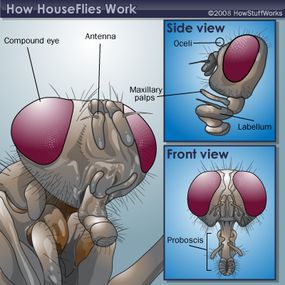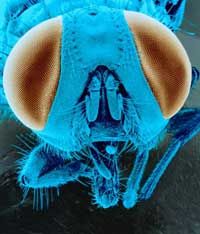Housefly Anatomy: The Head
Though houseflies are rulers of the insect-scavenging world, they have many predators just waiting for a chance to gobble them up. Spiders, frogs, lizards, sparrows, wasps -- even members of the plant kingdom -- want a slice of the housefly pie. On top of that, disease-conscious humans try to shut houseflies out or exterminate them once they're inside. To help overcome all these obstacles, houseflies depend on excellent sensory awareness and top-notch aerial maneuverability.
Like all insects, a housefly's body is covered with a hard exoskeleton of chitin and is divided into three sections: head, thorax and abdomen.
Advertisement
A pair of large complex eyes covers most of the housefly's head. Each eye is composed of 3,000 to 6,000 simple eyes. Unlike the eyes of vertebrates, houseflies can't focus in on the particulars of the environment around them. Instead, they provide an excellent mosaic view of everything to the left, right, front and above the fly.
Imagine a casino security guard, constantly scanning a bank of video monitors to see who might be cheating, causing a drunken disturbance or suspiciously loitering. The guard scans key areas for potential threats. It's much the same with the eyes of the flies -- only they have thousands of monitors that allow them to detect even the slightest of movements from nearly every direction.
Houseflies also boast three additional simple eyes called ocelli, located between the two compound eyes. Think of the ocelli as a kind of navigational device or compass, letting the fly know which way is up. The fly accomplishes this by keeping track and moving towards sunlit areas. This is why you'll often find houseflies buzzing around windows.

Houseflies depend on their keen sense of smell, provided by their antennae. For tasting and consuming meals, the insect uses its proboscis, a plunger-like appendage that extends from the bottom of the head. Two small, antenna-like feelers called maxillary palps allow the fly to taste its food. The end portion of the proboscis, called the labellum, terminates in a spongy mouth, where the fly slurps its food.
But how does the housefly get to its food? On the next page, we'll examine its amazing legs and wings.
